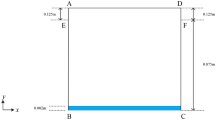Abstract
The parameters of the flow in the neighborhood of blunt bodies are investigated within the framework of the parabolized viscous shock layer model under Earth's atmosphere entry conditions for flow at angles of attack and slip. The investigation is carried out with allowance for thermal and chemical flow nonequilibrium, multicomponent diffusion, and heterogeneous catalytic reactions. The mutual influence of exchange reactions and molecular vibrational relaxation is taken into account, together with the vibrational-dissociative interaction. The effect of the flow nonequilibrium on the thermal and mechanical loadings is analyzed for the windward surface of triaxial ellipsoids.
Similar content being viewed by others
REFERENCES
A. A. Gladkov, O. Yu. Polyanskii, V. P. Agafonov, and V. K. Vertushkin, Nonequilibrium Physicochemical Processes in Aerodynamics [in Russian], Mashinostroenie, Moscow (1972).
G. A. Tirskii, “Modern gasdynamic models of hypersonic aerodynamics and heat transfer with allowance for viscosity and the real properties of the gas,” in: Modern Gasdynamic and Physicochemical Models of Hypersonic Aerodynamics and Heat Transfer, Vol. 1 [in Russian], Moscow University Press, Moscow (1994), P. 9.
R. Millikan and D. White, “Systematics of vibrational relaxation,” Chem. Phys., 39, 3209 (1963).
E. V. Stupochenko, S. A. Losev, and A. I. Osipov, Relaxation Processes in Shock Waves [in Russian], Nauka, Moscow (1965).
C. Park, “Assessment of two-temperature kinetic model for dissociating and weakly ionizing nitrogen,” J. Thermophys. Heat Transfer, 2, 8 (1988).
P. V. Marrone and C. E. Treanor, “Chemical relaxation with preferential dissociation from excited vibrational levels,” Phys. Fluids, 6, 1215 (1963).
L. A. Ladnova, “Nonequilibrium viscous shock layer with an arbitrary surface catalyticity,” Vestn. LGU, Ser. Matematika, Mekhanika, Astronomiya, 13, No. 3, 103 (1969).
G. I. Zalogin, “Vibrational-dissociative relaxation of nitrogen in a hypersonic shock layer at moderate Reynolds numbers,” Izv. Akad Nauk SSSR, Mekh. Zhidk. Gaza, No. 6, 105 (1976).
A. G. Tirskii, S. V. Shchelin, and V. G. Shcherbak, “Simulation of chemically and thermodynamically nonequilibrium flow past bodies moving along gliding trajectories,” Mat. Modelirovanie, 2, No. 4, 28 (1990).
A. G. Tirskii and V. G. Shcherbak, “Effect of vibrational relaxation in chemically nonequilibrium air flows past bodies with allowance for viscosity,” Izv. Akad Nauk SSSR, Mekh. Zhidk. Gaza, No. 1, 151 (1990).
G. V. Candler and R. W. MacCormack, “The computation of hypersonic ionized flows in chemical and thermal non-equilibrium,” AIAA Paper, No. 88-0511 (1988).
M. P. Netterfield, “Validation of Navier-Stokes code for thermochemical nonequilibrium flows,” AIAA Paper, No. 92-2878 (1992).
S. Seror, M.-C. Druguet, E. Schall, and D. A. Zeitoun, “A coupled vibration-dissociation-exchange reaction model for hypersonic air flow computations,” AIAA Journal, 36, 532 (1998).
S. V. Peigin, V. Yu. Kazakov, M.-C. Druguet et al., “3-D thermochemical nonequilibrium viscous gas flows over blunt bodies with catalytic surface at attack and slip angles,” AIAA Paper, No. 99-3628 (1999).
A. I. Borodin and S. V. Peigin, “Parabolized viscous shock layer model for investigating three-dimensional hypersonic viscous gas flow past bodies,” Teplofiz. Vysok. Temp., 31, 925 (1993).
A. I. Borodin, V. Yu. Kazakov, and S. V. Peigin, “Simulation of multicomponent chemically nonequilibrium flows with in the framework of the parabolized three-dimensional viscous shock layer model,” Mat. Modelirovanie, 8, No. 10, 3 (1996).
G. A. Tirskii, “Thermodynamically nonequilibrium effect in hyperbolic viscous gas flows past bodies,” in: Models of Mechanics of Inhomogeneous Systems [in Russian], ITPM SO AN SSSR, Novosibirsk (1989).
W. D. Breshears and P. F. Bird, “Effect of oxygen atoms on the vibrational relaxation of nitrogen,” Chem. Phys., 48, 4768 (1963).
J. H. Kiefer and R. W. Lutz, “The effect of oxygen atoms on the vibrational relaxation of oxygen,” in: Proc. 11th Symp. Combust. Pittsbusg; Combust. Inst. (1967), P. 67.
C. Park, “Problems of rate chemistry in flight regimes of aeroassisted orbital transfer vehicles,” AIAA Paper, No. 1730 (1984).
E. W. Miner and C. H. Lewis, “Hypersonic ionizing air viscous shock-layer flows over nonanalytic blunt bodies,” NASA. CR-250 (11975).
C. R. Wilke, “A viscosity equation for gas mixtures,” J. Chem. Phys., 18, 517 (1950).
E. A. Mason and S. C. Saxena, “Approximate formula for the thermal conductivity of gas mixtures,” Phys. Fluids, 1, 361 (1958).
L. V. Gurvich, I. A. Veits, and V. A. Medvedev, Thermodynamic Properties of Individual Substances Vol. 1, Book 2 [in Russian], Nauka, Moscow (1978).
D. A. Zeitoun, E. Schall, Y. Burtshell, and M.-C. Druguet, “Vibration-dissociation coupling in nonequilibrium hypersonic viscous flows,” AIAA Journal, 33, 79 (1995).
I. V. Petukhov, “Numerical calculation of two-dimensional boundary layer flows,” in: NumericalMethods of Solving Differential and Integral Equations and Quadrature Formulas [in Russian], Nauka, Moscow (1964), P. 304.
E. A. Gershbein, “Laminar multicomponent boundary layer for strong blowing,” Izv. Akad Nauk SSSR, Mekh. Zhidk. Gaza, No. 1, 64 (1970).
A. I. Borodin, V. Yu. Kazakov, and S. V. Peigin, “Multicomponent three-dimensional viscous shock layer on blunt bodies with catalytic surface at attack and slip angles,” Izv. Akad Nauk SSSR, Mekh. Zhidk. Gaza, No. 1, 143 (1990).
V. V. Lunev, Hypersonic Aerodynamics [in Russian], Mashinostroenie, Moscow (1975).
Rights and permissions
About this article
Cite this article
Kazakov, V.Y. Three-Dimensional Thermochemically Nonequilibrium Viscous Gas Flows in the Neighborhood of Blunt Bodies. Fluid Dynamics 36, 1004–1013 (2001). https://doi.org/10.1023/A:1017983130723
Issue Date:
DOI: https://doi.org/10.1023/A:1017983130723




